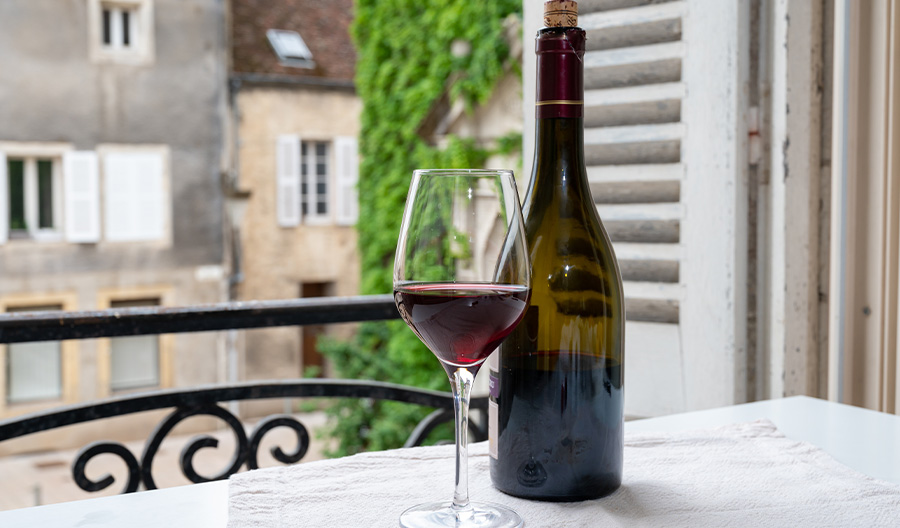When looking at and tasting Pinot Noir, Pinot Grigio (Gris) and Pinot Blanc, it might be surprising to learn that all these grape varieties are in the same family.
Pinot Gris, a greyish purple clone of Pinot Noir, produces light-bodied white wines with flavors that can range from fruity to citrusy. Pinot Blanc produces full-bodied whites, some of which spend time in oak. Lastly, there’s Pinot Noir, the grape that started it all. With origins in Burgundy, this red grape has spread across the world to produce a range of styles: from rich and fruity to delicate and earthy.
What is Pinot Noir?
Pronunciation: Pee-noh Nwahr
Pinot Noir is a red-wine grape variety identified most closely with the Burgundy region of France, where its history runs deep. Pinot Noir wines are typically medium-bodied, not overly tannic in texture and known for their flavor complexity. The grapes are used for still red wines, rosés and many sparkling wines both white and rosé in color.
Pinot Noir grapes on the vine are a deep blue-black color, usually set in small to medium-sized clusters that are tightly packed. Pinot Noir vines are one of the earliest types to begin spring growth and among the earliest to be harvested.
Pinot Noir is particular about the climate in which it grows and the soil in which it is rooted. Moderate to cool regions allow slow ripening and low-fertility soils keep the crop yields low, which generally promotes higher-quality wine. As a thin-skinned variety, Pinot Noir is susceptible to mildew and mold and needs extra attention from vineyard managers.
Pinot Noir Synonyms
In France; Auvernat, Auvernaut Noir, Franc Pineau, Franc Noirien, Pineau de Bourgoyne, Salvagnin, Morillon, Plant Doré and Vert Doré. In Germany; Spatburgunder, Burgunder Blauer, Clavner, Schwarzer Riesling, Schwarzer Burgunder. In Italy; Pinot Nero. In Austria; Blauer Nurnberger. In Hungary; Nagyburgundi.
Pinot Noir Regions
Pinot Noir grapes are densely planted in the French regions of Burgundy and Champagne, the former using them for still red wines and the latter for sparkling wines. Other regions with significant plantings of Pinot Noir include California, Oregon, Italy, New Zealand and Chile.
Virtually all red wines made in Burgundy use Pinot Noir grapes, from the basic Bourgogne Rouge to the rare and expensive bottlings from the districts of Chambertin, Volnay and Vosne-Romanée. High-quality versions are also produced in the Willamette Valley of Oregon, the Russian River Valley of California and the Marlborough area of New Zealand.
In Champagne and in sparkling wines from many other regions, Pinot Noir base wines are commonly blended with Chardonnay and/or Pinot Meunier base wines before they undergo a secondary fermentation that creates their bubbles.
Pinot Noir Tasting Notes
Wines made from Pinot Noir can be medium-to-light in color and are typically quite aromatic. They show fruity characteristics ranging from strawberries and raspberries, to red and black cherries along with possible mint, pine, tea and forest floor nuances.
Pinot Noir is considered a medium-weight wine because its tannins and alcohol tend to be lower than other popular varietal wines such as Cabernet Sauvignon and Syrah. Pinot Noir is versatile in food pairing and is a classic match for seafood dishes such as salmon or fresh tuna.

What is Pinot Grigio/Gris?
Do you like the pear-fruited notes of Pinot Grigio, but long for something more substantial, generous, and even weighty? Switch languages and head north to France’s Alsace wine region, where Italian grigio changes into French gris.
Pinot Gris/Grigio is a grayish-purple grape that yields a white wine with a refreshing character. It is a versatile grape that produces a wide variety of styles depending on the region and winemaking style; some (like those from Alsace) can be full-bodied with a rich, somewhat floral bouquet while others (like those from Italy) can be crisp and light-bodied with dominating citrus aromas.
One of the aspects that gives Alsace Pinot Gris such substance and character, even if the style is dry and fruit-driven, is restricted yields. Many winemakers focus on a clean-cut, dry style that’s suited to contemporary cuisine, but this requires hawk-like attention to harvest date and selection.
While Pinot Grigio and Pinot Gris are indeed the same grape, different growing conditions have a significant impact on the resulting wines. In northeastern France, the climate is dry and sunny. During extended autumns, the variety attains rich flavors due to full aromatic development, achieved particularly well in south- and southeast-facing vineyards that run along the eastern slopes of the Vosges. Botrytis, or noble rot, is also a distinct possibility.
What is Pinot Blanc?
Pinot Blanc is a white wine grape that is best known for its plantings in the Alsace region of France. In the vineyard, this grape has a rosy, near-pink hue. Pinot Blanc is actually a mutation of the red grape Pinot Noir, and, like Pinot Gris, is not a purely white grape. Instead, there is pigment in the skin, leading to color in the juice and fleshiness and body in the resulting wines.
On the palate, Pinot Blanc medium to full in body and offers apple, citrus, white flower and, sometimes, stone fruit, with a backbone of minerality. These wines are typically produced with youthful consumption in mind and are often vinified without oak contact. In warmer climates, the grape tends to show some tropical notes, like passion fruit and other tropical fruits.
Pinot Blanc is widely planted in Alsace, where it is typically blended with Auxerrois. The grape is used to make still white wines as well as Crémant d’Alsace, a sparkling wine made using the traditional method of production. Stellar examples of Pinot Blanc are grown in Germany, where the grape is known as Weissburgunder. Pinot Blanc is also grown in Italy, Luxembourg, Austria, Spain, the Czech Republic and Slovakia. In the New World, winemakers in Canada’s Okanagan Valley, South Africa and parts of California have had success with the grape.
Synonyms
Burgundac Bijeli, Fehér Burgundi, Klevner, Pinot Bianco, Pinot Bijeli, Weissburgunder

